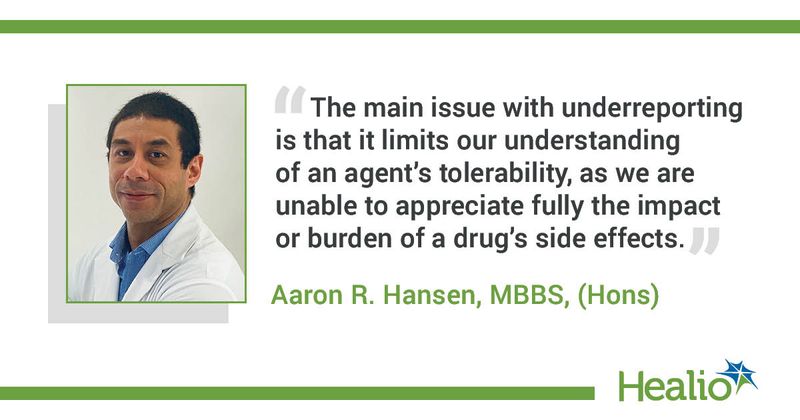Clinicians may underreport adverse events in phase 1 trials
Patient-clinician agreement for symptomatic adverse events in phase 1 trials appeared moderate to poor, suggesting clinicians are underreporting toxicity, according to a study published in Journal of the National Cancer Institute.
Results of this prospective, single-center observational trial are important because patient-reported outcomes have potential to inform tolerability of experimental therapies and influence oncology drug approvals, according to the researchers.

“An important objective of a phase 1 trial is to determine tolerability of an experimental regimen. However, there is no clear definition of how that would be done, and it seemed strange that tolerability would be decided by the clinicians and not the patients,” Aaron R. Hansen, BSc, MBBS (Hons), clinical research fellow and medical oncologist in the division of medical oncology and hematology at Princess Margaret Cancer Centre in Toronto, told Healio.
“We wanted to inform the symptomatic adverse events that occurred on trial with the patients’ perspective,” he added. “Hence, we developed our study in order to collect this information directly from patients.”
The analysis included 243 patients (median age, 60 years; 51% women) who were evaluated and deemed eligible for inclusion in phase 1 solid tumor trials at Princess Margaret Cancer Centre between May 2017 and January 2019.
The patients completed the patient-reported outcomes version of the Common Terminology Criteria for Adverse Events (PRO-CTCAE) survey at three study timepoints: prior to initiation of investigational therapy, mid-cycle 1 and mid-cycle 2, results of which researchers compared with clinician-reported events captured using CTCAE version 4.0.
Defining agreement between PRO-CTCAE and CTCAE responses overall, at baseline and after initiation of therapy served as the study’s primary endpoint.
Median follow-up for 219 patients receiving phase 1 study treatment was 8.1 months.
In total, researchers evaluated 552 PRO-CTCAE surveys, representing a 98.7% completion rate. Patients reported fatigue, pain and anxiety categories most frequently.
Overall, researchers identified 50 PRO-CTCAE and 11 CTCAE items with 10% or greater reporting frequency.
Clinicians reported 19 CTCAE items at a frequency of 1% or less, despite patients reporting these matched PRO-CTCAE items at a frequency of at least 10%. Clinician-underreported categories included sexual health, bodily emissions, cognition and visual disturbances.
Researchers found nine symptomatic adverse events — decreased libido, palpitations, wheezing, voice alteration, hiccups, hyperhidrosis, vaginal dryness and urinary incontinence — with at least a 50-fold lower clinician- relative to patient-reporting frequency.
They concluded overall patient-clinician agreement for individual symptomatic adverse events ranged from poor (kappa = 0-0.19) to moderate (kappa = 0.4-0.59), with the lack of clinician reporting driving the discordance. Adverse events with the highest clinician-patient agreement included dyspnea (kappa = 0.54) and peripheral neuropathy (kappa = 0.63) at baseline, and limb edema (kappa = 0.55) at the end of cycle 2.
“When we for the first time demonstrated that this lack of agreement occurred in phase 1 trials, it confirmed our initial hypothesis,” Hansen said. “The main issue with underreporting is that it limits our understanding of an agent’s tolerability, as we are unable to appreciate fully the impact or burden of a drug’s side effects.”
There are several explanations for the discordance, according to Hansen.
“The electronic survey used in our study prompts patients for side effects, allowing them to consider every PRO-CTCAE item,” he said. “Whereas, with the clinician, in a time-sensitive clinical environment, a patient may not be able to recall all of their symptoms, they may choose only to report the symptoms they think are notable, or they may choose not to report socially or culturally sensitive symptoms, [such as] genitourinary or sexual function.”
Clinicians also may not document mild or subjective adverse events, or those they deem unrelated to the study, he added.
Hansen and colleagues plan to collect longitudinal data on patients beyond the first two cycles, utilizing a phase 1-specific survey with fewer items than PRO-CTCAE that may be less burdensome on patients. They also plan to collect quality-of-life and other patient-reported outcome information to better understand tolerability and inform the design of endpoints related to these measures for later-phase trials.
“We need to incorporate patient-reported outcomes into all phase 1 clinical trials in order to collect these data, and we need to start reporting the patients’ perspective on their symptomatic adverse events,” Hansen said. “We should not be striving for a binary understanding of tolerability ... but, rather, clinicians need to describe symptomatic adverse events in terms of their severity and interference and the impact on patients.”

This study represents a “meaningful contribution” to understanding the use of patient-reported outcomes in phase 1 trials, Ethan Basch, MD, MSc, director of the cancer outcomes and research program at UNC Lineberger Comprehensive Cancer Center and distinguished professor of medical oncology at UNC School of Medicine, and Christina Yap, PhD, professor of clinical trials biostatistics at The Institute of Cancer Research in the U.K., wrote in an editorial accompanying the study.
However, they added there needs to be more clarity in how such information should be used best in early-phase trials.
“To achieve patient-centered drug development, methods are needed for integrating patient-reported outcomes into early-phase trials,” Basch and Yap wrote. “Substantial strides have been made in this direction. Patients are the ultimate recipients of drugs, so their perspectives are essential to determining tolerability.”
References:
Basch E and Yap C. J Natl Cancer Inst. 2021;doi:10.1093/jnci/djab017.
Veitch ZW, et al. J Natl Cancer Inst. 2021;doi:10.1093/jnci/djab015.
For more information:
Aaron R. Hansen, BSc, MBBS (Hons), can be reached at Princess Margaret Cancer Centre, 700 University Ave., 7-623, Toronto, ON, M5G 1Z5, Canada; email: aaron.hansen@uhn.ca.
